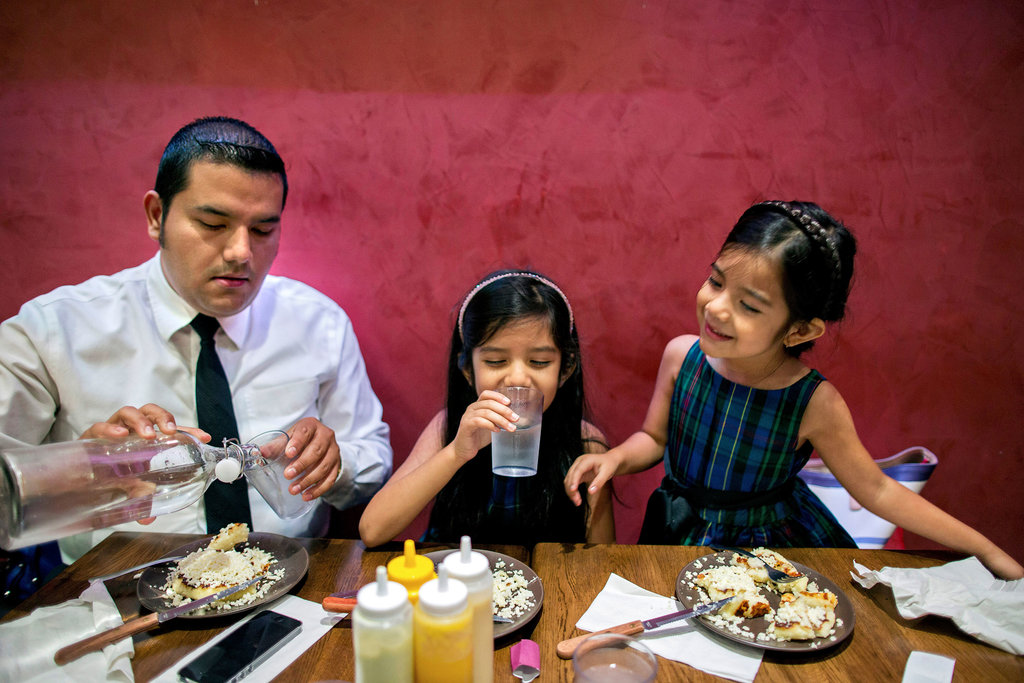
Arepa Lady
CreditBrian Harkin for The New York Times
It must be a Friday or a Saturday, from April to October, after 10 p.m. — the later the better — and still you may not find her, Maria Piedad Cano, the once and future Arepa Lady of Jackson Heights, Queens.
For more than two decades, she has parked her cart among the late-night roisterers of Roosevelt Avenue. Early in her career as a street vendor (previously, in Colombia, she was a lawyer and a judge), she was canonized in The New York Press by Jim Leff, who later helped found Chowhound. Now 70, she remains his seraphic archetype: a tiny, bright-eyed woman with a halo of reddish hair and the kind of smile typically achieved only after years of solitary meditation, making the quicksilver toss of a $4 corn cake on a griddle a gesture at once elegant and magnanimous.
Like all great street vendors, she is half mirage; part of the thrill is not knowing if she will appear. But since June, her arepas have been available almost daily, at normal waking hours, at a small restaurant in Elmhurst, two blocks from the cart’s usual station, opened by her sons Douglas Arevalo and Alejandro Osorio.

The sign says Arepa Lady, although the unofficial name, in homage, is Arepa Lady 2. The space is trim, with plants in bright little pots and sturdy chairs with backs and padded seats — more comfortable than need be given that the menu is as brief as the cart’s and features only three types of arepas, heretofore consumed in minutes while standing on the sidewalk.
Arepas are still $4 each (add $4 for meat) but served on proper plates. Napkins are paper, but rolled in burgundy bands that match the whorled-paint wall. Fresh juices — mango, passion fruit, blackberry and lulo (a fruit whose flavor weds lemon and pineapple) — are loosened with water or plumped with milk and presented frothy in Mason jars. The room is filled with Spanish and kisses: Everyone seems to be a regular or a friend, and here, perhaps, it’s the same thing.
Ms. Cano prepares the arepas; Mr. Osorio and his wife, Nelly Klinger, grill them. Does the magic hold? Yes, on evidence of the arepa de queso, a thick moon of a corn cake with closely set air pockets that make it seem as if it’s contracting and expanding at the same time. The dough, made with a flour of corn that has been cooked, then ground, is faintly sweet and velvety from mozzarella kneaded in. Inside is all give, outside a veneer of crispy patches and crumbs of salty-sour queso blanco with a touch of bounce.

The arepa de choclo, made with fresh corn that is ground at the restaurant, is sweet too, but larger in circumference and pancake-thin. It arrives half flopped around more queso blanco and a munificent heap of steak, charred with chewy corners; chorizo with contours of smoke; or chicken, simple and fine. (This is a break from cart tradition, where meat is available only separately, as chuzos, or skewers.)
The third offering, the arepa tela, is closer to a tortilla, a savory base for queso blanco and meat. At the cart, it can seem like the least-favored child, often too crisp and threateningly salty. Here it is suppler and more mellow, a worthy challenger.
At the cart, I prefer my arepas unadorned, but half the fun here is to mix and match the squeeze bottles that the waitress (that is to say, Ms. Klinger) brings out. She’ll explain which are which, but taste first, in case they’ve become mixed up: vinegary Cholula hot sauce; rosada, or pink sauce, a quick equation of mayonnaise and ketchup; garlicky mayonnaise, pale green from cilantro; and pineapple sauce and sweetened condensed milk, which help the arepa de queso fulfill its secret destiny as dessert.
Still, no restaurant can replicate the miracle of an arepa de queso handed to you straight off the griddle, cheese inside caught in flagrante, shapeshifting, ready to gush out. So on a recent evening, I was relieved to find Ms. Cano wielding her spatula in the neon fog under the No. 7 train tracks, as lovely as ever.
“I want to hug her,” someone on the sidewalk whispered.